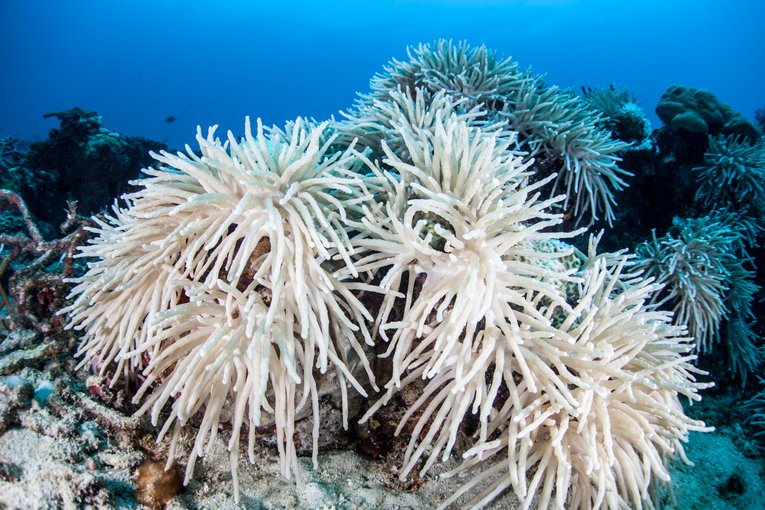
How the ocean and climate change are linked
The ocean could be a lifesaver when it comes to climate change. Discover how the ocean could protect us from a changing climate, as well as how climate change is currently impacting our ocean.
How the ocean helps fight climate change
The ocean provides crucial protection against the full effects of climate change. It absorbs carbon from the atmosphere, heat from our changing climate, and protects our coasts from erosion and storm damage. We must protect this superhero.
Absorbing and storing carbon
The ocean captures and stores around 30% of the CO2 emissions we release into the atmosphere. It has also absorbed 90% of the warming which has taken place in recent years as a result of human-driven climate change. These two processes are absolutely crucial in a landscape of ever-rising CO2 levels.
Marine habitats like seagrass meadows, kelp forests, coral reefs, and seaweed are vital carbon stores, much like forests on land. Even more so, in fact, with seagrass meadows alone estimated to absorb and store 35 times more CO2 than rainforests. Seaweed absorbs carbon more effectively and produces more oxygen than trees, storing an estimated 175 million tonnes of carbon each year.
We also know that the offshore environment in deep water sands and muds is the biggest store of carbon in the UK environment – with up to £1 billion worth of carbon storage in our deep-sea areas.
By removing carbon from the atmosphere and keeping it locked down, the ocean helps lower CO2 levels and protects us from rising temperatures. It essentially slows down climate change and prevents us from suffering its full impacts.
Coastal protection
Seagrass beds, coral reefs, mangrove and kelp forests also prevent and reduce coastal erosion – something which is on the rise due to climate change. By lessening the impact of waves and strong currents, these ocean superheroes provide coastal communities with vital protection from erosion and flood and storm damage. These coastal habitats aren’t just valuable to communities, but to the economy as well.
In the UK alone, coastal habitats save up to £33.2 billion pounds compared to the cost of man-made alternatives.
Renewable energy
The ocean can also help us achieve Net Zero and give us the best chance of combatting climate change by generating renewable energy, and the UK is looking to its marine areas to deliver this by 2030. By adding offshore wind, tidal and wave energy to the UK’s energy mix, we can shift towards clean energy and reduce our reliance on damaging fossil fuels which accelerate global heating and CO2 emissions.
However, shifting towards clean, renewable energy must not be at the expense of nature, and we need to protect and conserve the life beneath the waves giving us power. We need to minimise the impacts of offshore infrastructure on marine ecosystems and species, such as noise disturbances, collision risks and physical damage to the seabed.
We need renewable energy to tackle climate change. But it must be done in a nature positive way, underpinned by robust marine planning and environmental assessments that informs environmentally conscious construction.
Reducing our consumption of and reliance on fossil fuels should result in less pressure placed on our ocean, allowing it to continue to protect our coasts, absorb and store carbon, and help us fight climate change.
How climate change impacts the ocean
Rising temperatures
Ocean temperature is a key indicator of climate change, with 90% of global warming occurring in the ocean. Temperatures have been increasing since records began in 1995, with 2024 bringing the highest ocean temperatures ever recorded.
As sea temperatures rise, so too does the risk of losing our marine and coastal ecosystems, with many marine species sensitive to even slight changes in ocean temperature.
Heatwaves of 3-4°C in tropical countries have been causing significant coral death at regular intervals since 1998, and our surveys in Maldives are finding a lower abundance, complexity and diversity of coral reefs due to repeated ocean warming. Even short heatwaves have led to catastrophic losses of seagrass habitats, fish, and impacting the long-term survival and reproduction rates of dolphins.
In March 2024, the fifth mass bleaching event on the Great Barrier Reef was confirmed by NOAA

Bleached corals taken in the Western Pacific
Credit: Ethan Daniels via shutterstock
Some marine species are moving further north to cooler waters, such as those on the west coast of the USA, whilst our most impressive predatory fish are having to hunt in a reduced oxygen environment caused by ocean warming in the upper areas of the ocean.
Changes can be seen in populations, too. Temperature determines the sex of turtles, with warmer temperatures resulting in females developing. We’re now seeing more female turtle hatchlings in tropical beaches, because of the sand being too hot for males during developmental phase.
If ocean heating trends continue, more than half of the world’s marine species may be on the brink of extinction by 2100. Vital habitats such as kelp forests, seagrass beds and oyster reefs will deteriorate further and could eventually die-off, sponge beds and other coastal species won't be able to filter our seawater, removing pollutants, and a warming of 1.5°C threatens to destroy 70-90% of coral reefs.
Rising sea levels
Every year, the sea rises another 3.2mm, and by 2050, it’s projected to rise by 30cm. Rising sea levels are caused by ice and glaciers melting and the fact that water expands as it gets warmer - so as the sea temperature rises, so does the level.
Coastal erosion caused by rising sea levels leads to habitat loss, for both marine life and coastal communities. Species which live or depend on beaches are impacted, with more saltwater on the shores disrupting important ecosystems like salt marshes. Changes to the enzymes and mineralisation in soil in the ecosystem leads to the loss of different plant species, with wildlife on beaches also impacted by the rapid changes to the environment.
Ocean acidification
When the ocean absorbs carbon dioxide from the air, the carbon reacts with the water, making it acidic. As more carbon dioxide is released into the atmosphere, the ocean absorbs more, making it increasingly acidic.
Ocean acidification leads to lower pH levels in the water and can reduce calcification in seaweeds, which can affect their ability to grow, photosynthesise and compete for food, water, and space.
Storms
Our climate is becoming wetter and stormier, and most climate projections suggest that this will continue to be the case. This will undoubtedly impact our seas and those living in it, as well as coastal communities.
The powerful waves brought by storms damages vital marine habitats like seagrass beds, impacting their ability to absorb carbon, stabilise the seabed, and act as feeding and breeding grounds for marine life.
Without marine habitats the cost of investment in man-made defences such as seawalls would be significantly higher.
Why we must protect our ocean
The ocean is one of our greatest assets and best chances at combatting climate change and its impacts – but our seas are also facing these impacts. It’s more important than ever to protect, conserve and restore our ocean and its vital ecosystems, so it can continue to provide the countless benefits it brings people, wildlife, and planet.
The UK is also a signatory to the Paris Agreement. The central aim of this agreement is to keep the global temperature rise this century well below 2°C above pre-industrial levels and increase our efforts to limit this even further, to 1.5°C.
What must be done
To save the ocean, we must decarbonise our economies and bring our carbon emissions down to net-zero (carbon neutral) as soon as possible – we must urgently invest in our capacity to produce renewal energy sources as an alternative to fossil fuels.
The ocean can help us make significant emissions cuts needed to keep global warming below 1.5°C, if we:
- Rewild large swathes of our seabed, to protect and restore marine and coastal habitats and marine wildlife populations, and to increase the ocean’s ability to lock away millions of tonnes of ‘blue carbon’ and ‘fish carbon’
- Reduce our plastic and chemical footprint to improve the ocean’s health
- Invest in developing truly sustainable (or climate and nature positive) fisheries that are less reliant on fossil fuels and don’t overfish or damage the seabed, and, better managed and innovative aquaculture
- Ensure that everyone understands the crucial role the ocean plays in helping us fight climate change so we can all be much kinder in how we treat it.
2024
was was the world's warmest year on record
30
%
of our carbon emissions are captured and stored by the sea
90
%
of the ocean experienced heatwave conditions during 2023
We're striving to raise awareness, carry out research and work with governments to bring about meaningful change. Will you join us?






